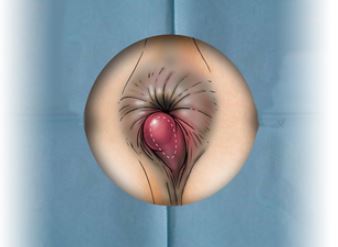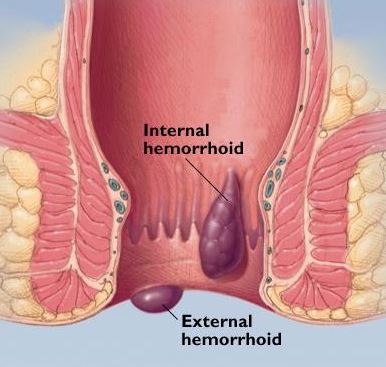What is Thrombosed Hemorrhoid?
Thrombosed hemorrhoid is external hemorrhoids that have ruptured or they ruptured and developed a clot. In most cases they can become strangulated and cause extreme pain.
Hemorrhoids are vascular structures within the anal canal and are also known as piles. These hemorrhoids are blood filled sacs that are used as cushions that help with stool control. They become a disease when they are swollen or inflamed. Hemorrhoids can be classified as external hemorrhoids which are found outside the anal canal and can be very painful or internal which can protrude and bleed.

Who are Affected?
About 50% to 66% of people are affected by thrombosed hemorrhoids at some point in the course of their lives. This condition is more prevalent among people that are within the age of 45 to around 65 years of age. This condition affects both men and women with equal prevalence.
Signs & Symptoms
The symptoms for thrombosed hemorrhoid vary depending on where they are located whether external, which is outside the anal canal or internal, which are found within the anal canal.

External
External hemorrhoids can be very painful, however this pain resolves in two to three days but the swelling however may take a few weeks to fully disappear leaving behind a skin tag where it once was after it has fully healed.
When thrombosed hemorrhoid are large they can cause problems with hygiene and produce irritation on that area of skin that surrounds the thrombosed hemorrhoid and therefore itchiness around the anus.
Internal
Internal thrombosed hemorrhoid is usually painless. However during or after bowel movement you might experience bright red rectal bleeding.
The blood can cover the stool which is a condition that is known as hematochezia. The stool however presents its own normal color. Other symptoms for internal thrombosed hemorrhoid may include the following:
- Presence of a mucous discharge
- You may experience itchiness within the anal canal
- The hemorrhoids may protrude through the rectum as a perianal mass in cases where prolapse (a condition where organs fall out of place) occurs.
- You may also experience the inability to control defecation leading to the loss of bowel contents this condition is also known as fecal incontinence
Is it Dangerous?
Thrombosed hemorrhoid is usually painful but after treatment the outcome is usually good. Bleeding as a result of thrombosed hemorrhoid is rare while life threatening bleeding from a thrombosed hemorrhoid be it internal or external is even more uncommon.
Does it Matter How Long they Hurting?
Surgical modes of treatment for an external hemorrhoid can best be performed during the first 3 days after the first onset of its symptoms, which may achieve significant relief from pain. After that 3 day window the pain relief achieved after surgery may be insignificant to the discomfort from the surgery itself.
Causes
The exact cause of thrombosed hemorrhoid remains unknown however a number of some factors are believed in having a role in causing thrombosed hemorrhoid. Such factors include:
- Irregular bowel habits such as constipation and diarrhea
- Lack of exercise
- Nutritional factors such as taking foods with low fiber content
- Increased intra-abdominal pressure such as during pregnancy
- Prolonged straining also causes intra-abdominal pressure and therefore causing thrombosed hemorrhoid
- Sitting for long hours
- Genetics
- The absence of valves within the hemorrhoidal veins
- Aging
- Anal intercourse
- Rectal cancer
- Inflammatory bowel disease such as Crohn’s disease and ulcerative colitis
During pregnancy both pressure from the developing fetus as well as the hormonal changes cause hemorrhoidal vessels to enlarge. The birth of the baby also cause increased intra-abdominal pressures. However pregnant women rarely need surgical treatment as the symptoms usually resolve after pregnancy.
Obesity, chronic cough and pelvic flow dysfunction are said to cause thrombosed hemorrhoids although the evidence for these factors are weak and circumstantial.
Diagnosis
Physical exam
Thrombosed hemorrhoid is typically diagnosed through a physical examination. You visually examine the anus and the surrounding area where you may find external thrombosed hemorrhoid or prolapsed hemorrhoids.
Rectal exam
A rectal exam may also be performed to check for the presence of rectal tumors or an enlarged prostrate. Such examinations may not be possible without the use of a sedative to numb the pain.

Examination revealing External blooeding Thrombosed Hemorrhoid
Anoscopy
Although internal thrombosed hemorrhoid is often painless to check for their presence anoscopy may be required, where a tube with a light on one end is inserted into the anus.
Classification of Internal
Internal thrombosed hemorrhoids are classified into grades according to the degree if the prolapse and they include:
Grade 1: There is prolapse just prominent blood vessels
Grade 2: There is a prolapse upon bearing down requiring spontaneous reduction
Grade 3: There is a prolapse upon bearing down requiring manual reduction
Grade 4: Prolapse with no ability to be reduced
Treatment
Treatment of thrombosed hemorrhoid may range from taking medication to surgical operations depending on the severity of the thrombosed hemorrhoid.
Depending on the severity of the hemorrhoids, different treatment approaches may be opted. Your doctor will determine the best option.
Medication
Ointments that protect the skin can be applied in cases of external thrombosed hemorrhoids. Such ointments can help prevent further injury and reduce itching by forming a barrier over the hemorrhoids. Such ointments include petroleum jelly or zinc oxide.
- Apply ointment that contain, hydrocortisone, which is a type of steroid medicine that may relieve you from the inflammation and the itching. However such medication should not be taken for more than two weeks.
- Apply local anesthetics to numb the thrombosed hemorrhoid.
- Taking some over the counter pain relievers such as acetaminophen also known as Tylenol, Aspirins, other non-steroidal medication such as Ibuprofen and naproxen to help with the pain and swelling.
- Taking a sitz bath, which is soaking in warm water, allowing the anal area to be covered in warm water especially after bowel movements for periods of up to 20 minutes. However take caution not to burn yourself if the water is too warm.
It is important to note that medication only helps to relieve the symptoms.
Surgical Treatment
An incision can be made over the clot allowing the doctor to physically squeeze out the clot or a more extensive measure can be done where both the clot and the blood vessels in the hemorrhoid are removed.
- Rubber band ligation involves tying of a rubber band at the base of the hemorrhoid and therefore restricting its blood supply causing it to fall in two to three days.
- Sclerotherapy involves injecting a hardening agent to the hemorrhoid and works similarly to rubber band mitigation.
- As a last resort, hemorroidectomy procedure may be performed. This is for the severe cases of thrombosed hemorrhoid. In this surgical procedure, the hemorrhoids are entirely removed. It is an invasive procedure and often requires a patient to stay in a hospital. It also requires adequate recovery time during, which a patient may experience extreme discomfort. 4
Prevention
You can prevent the symptoms of hemorrhoids by:
- Avoiding constipation, which entails eating foods with high fiber content, drinking lots of fluid as well as exercising.
- Practicing proper bowel habits such as going to the bathroom as soon as you have the urge, avoid holding your breath when passing stool, avoid straining to pass off stool and finally avoid sitting on the toilet to read after passing off stool.
Reference List
- Hemorrhoids. http://www.emedicinehealth.com/hemorrhoids-health/page10_em.htm
- http://emedicine.medscape.com/article/81039-overview#showall
- Hemorrhoids. http://www.davidrosenfeldmd.com/brochures/hemorrhoids/
- Thrombosed Hemorrhoids. https://www.hemorrhoidinformationcenter.com/
- Thrombosed External Hemorrhoids. http://www.med.umich.edu/1libr/Surgery/GenSurgery/ThombosedHem.pdf
- What are Hemorrhoids: http://www.webmd.com/digestive-disorders/understanding-hemorrhoids-basics#1

One comment